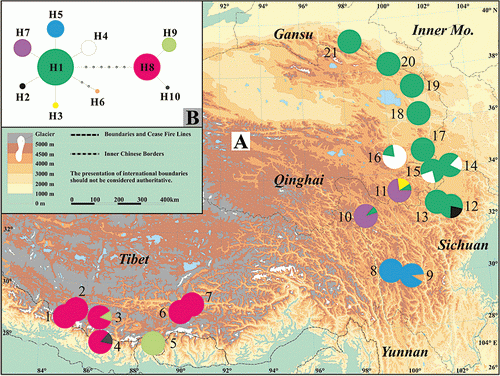Increasing evidence suggests that geological or climatic events in the past promoted allopatric speciation of alpine plants in the Qinghai-Tibetan Plateau and adjacent region. However, few studies have been undertaken to examine whether such allopatric divergences also occurred within a morphologically uniform species. In the present study, we report the evolutionary history of an alpine shrub species, Hippophae tibetana, based on examining chloroplast DNA (cpDNA) and nuclear ribosomal internal transcribed spacer (ITS) DNA variations. We sequenced two cpDNA fragments (trnL-F and trnS-G) and the nuclear ITS region in 183 individuals collected from 21 natural populations. Ten chlorotypes and 17 ITS types were identified. Phylogenetic analyses of both chlorotypes and ITS sequence variations suggested two distinct lineages distributed in the eastern and western region, respectively.
On the basis of the fast and low plant substitution rates, these two lineages were estimated to have diverged from each other between 1 and 4 million years ago, during the period of the major glaciations and orogenic processes. In addition, ITS has undergone the accelerated evolution in two populations in the southern Himalaya isolated by the high mountains with a surprising accumulation of the private variations. The east–west split was also supported by an analysis of molecular variance, which partitioned around 91% of the total cpDNA variance between these two groups of populations. A single chlorotype was found for most populations in eastern or western region, suggesting a recent postglacial expansion within each region. Star-phylogeny and mismatch analyses of all chlorotypes within the eastern group of populations suggested an earlier regional expansion before the Last Glacial Maximum (LGM). The local fixture of the different chlorotypes in multiple populations suggested more than one refugia remained for eastern or western region. Coalescent tests rejected the hypothesis that all current populations originated from a single refugium during the LGM. Instead, they supported hypothesis that two lineages diverged before the late Pleistocene.
These findings, when taken together, suggested that this species had experienced long allopatric divergence and recent regional range expansions in response to orogenic processes and the climate changes. The evolutionary history of this shrub species highlights importance of geographical isolations to the intraspecific divergence of alpine plants occurring in the world's ruff.

Figure. A, map of the sampling sites (Table 1) and the geographic distribution of Hippophae tibetana chloroplast DNA (cpDNA) haplotypes.
Pie charts show the proportions of chlorotypes within each population.
B, the network of chlorotypes as inferred from TCS.
Circle sizes are proportional to chlorotype frequencies within the total sample and small dots indicate unidentified chlorotypes.
Additional Information:
1. Author Information:DONG-RUI JIA1,3, TENG-LIANG LIU1, LIU-YANG WANG2, DANG-WEI ZHOU2, JIAN-QUAN LIU1,2,*
Correspondence: liujq@nwipb.ac.cn
2. Publication History:
First published online: 18 NOV 2010
January 2011,Biological Journal of the Linnean Society, 102: 37–50.
